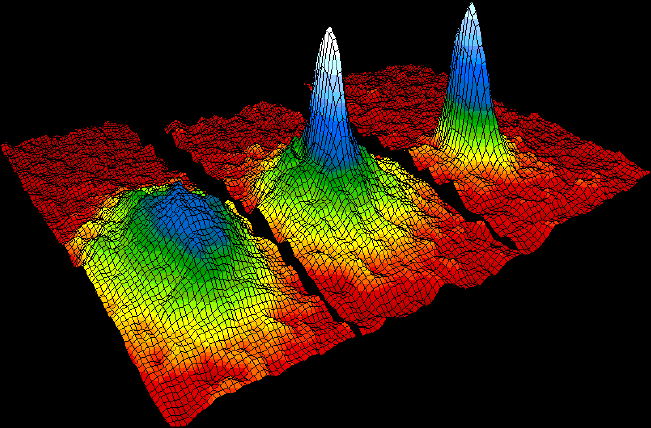One of the greatest tragedies of quantum mechanics is what makes it so fascinating: its scale. Its effects are completely intangible to the naked eye, which makes them all the more paradoxical and difficult to comprehend. Simply put, the quantum mechanical world is nothing like our own classical world; the way in which we have evolved to observe the world around us makes any attempt to intuitively understand the quantum world nearly impossible. Because of this, the everyday person shudders at the mention of anything “quantum”. Soon enough, though, everyday life will be entirely intertwined with it.
The Bose-Einstein Condensate (BEC), occasionally referenced as the fifth state of matter, addresses this issue of unfathomable intangibility. It is a macroscopic manifestation of quantum phenomena. It is an experimental wonder.
But first, in order to understand the Bose-Einstein condensate, one must understand the basic laws of quantum mechanics that predict its existence.
Wave-Particle Duality: You might remember learning about this in your chemistry class (the double slit experiment). It states that a subatomic particle (electron, photon, etc) can exhibit properties of both a wave and a particle, simultaneously. The wave properties of these kinds of particles are crucial to the formation of a BEC.
Heisenberg Uncertainty Principle: The more one knows about the position of a particle, the less one knows about its velocity, and vice-versa.
Temperature: The average kinetic energy of a particle or particles in a substance.
Kinetic Energy: 12mv2. Note the v, which denotes velocity. It ties into the Heisenberg Uncertainty Principle, which, as you will have seen, relates velocity and position. Kinetic energy itself goes hand in hand in hand with temperature.
In accordance with wave particle duality, you must abandon your conception of the atom as a solid, classically observable object. Instead, think of it as having particle- and wave-like traits, at once. This definition makes the Heisenberg Uncertainty principle much easier to understand. Simply put, the position and momentum of particles are defined by their waves, which display their possible momentums and positions at any moment in time.
Now, as atoms are cooled, their average kinetic energy lessens; they vibrate at lower frequencies than before. In a wave, energy is characterized by wavelength: a shorter wavelength indicates higher energy; a longer wavelength indicates lower energy. Thus, the cooling of these particles lengthens the wavelengths of these atoms.
As we continue to cool the atoms, we know more and more about their energy (velocity). Thus, according to the Heisenberg Uncertainty Principle, we know increasingly less about their position. If we are to imagine the wavelengths of these particles, this makes sense; imagine every atom existing as ever-expanding wavelengths. If their exact position can be on any part of the wavelength, then it is nearly impossible to know where it truly is at a specific moment in time.
As we asymptotically approach 0 K (Kelvin), the atoms have very little kinetic energy left, and thus their positions are as blurry as ever, so much so that their wavelengths are overlapping each other. When a certain temperature is reached, this ambiguity of the waves results in a condensation of these atoms into a singular, macroscopic wave-like particle. This condensate behaves like a single atom, despite being made up of many of them, allowing scientists to observe the quantum mechanical effects of an atom at a much larger scale.
But what is the practicality of BEC? Well, there may not be much immediate use for them outside of the lab. For now, the methods of refrigeration required to create them render them entirely impractical outside of research. However, their experimental value is undeniable. The intricacies of the quantum realm make scientific observation exceedingly difficult, and so the ability to create an entity that is much more easily observable but still exhibits the behavior of a single atom facilitates great advancement in quantum physics research.
And quantum physics is the future, after all, and most prominently so in quantum computing. In cyberwarfare, the arrival of a practical quantum computer may be equivalent to that of the nuclear bomb in conventional warfare. But as the world is seeing with artificial intelligence, for all its potential dangers, the quantum computer will also offer countless possibilities for scientific advancement. Their power may even be linked to our own mortality; the processing capabilities of quantum computing are expected to extend the horizons of drug discovery and development dramatically.
The Bose-Einstein Condensate, as abstract as it seems, has played and continues to play a key role in quantum research.



